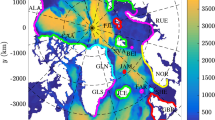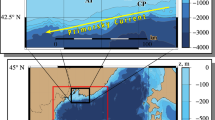Abstract
To conduct the simulation of oil spills in the Sea of Okhotsk, we developed a three-dimensional, high-resolution ocean circulation model. The model particularly improved the reproducibility of velocity field during the strong stratification period. Particle-tracking experiments with the effects of evaporation and biodegradation were performed using the combined data of daily ocean currents from the present model and the hourly diurnal tidal currents from the tidal model. The results are shown by the relative concentration of the particles averaged over the 8 years of 1998–2005 based on the ensemble forecast idea. For the case of particles released from the Sakhalin II oil field, the particles deployed in September–January are carried southward by the East Sakhalin Current, finally arriving at the Hokkaido coast, after 60–90 days. The particles deployed in March–August are diffused offshore by the synoptic wind drift, and hardly transported to regions south of Sakhalin. For the case of particles released from the region off Prigorodnoye, the oil export terminal, after the diffusion by the synoptic wind drift, a part of them are carried offshore of Hokkaido by the Soya Warm Current. The particles released in November–April flow out to the Japan Sea through the Soya Strait, mainly by the synoptic wind drift and secondly by the diffusion due to strong tidal currents around the Soya Strait. By considering the effects of evaporation and biodegradation, the relative concentration of the particles is considerably decreased before arriving at the Hokkaido coast, particularly in the case of drift from the Sakhalin II oil field.










Similar content being viewed by others
References
Aota M (1975) Studies on the Soya Warm Current. Low Temper Sci Ser A 33:151–172 (in Japanese with English abstract)
Csanady GT (1978) The arrested topographic wave. J Phys Oceanogr 8(1):47–62
Ebuchi N, Fukamachi Y, Ohshima KI, Shirasawa K, Ishikawa M, Takatsuka T, Daibo T, Wakatsuchi M (2006) Observation of the Soya Warm Current using HF ocean radar. J Oceanogr 62(1):47–61. doi:10.1007/s10872-006-0031-0
Ebuchi N, Fukamachi Y, Ohshima KI, Wakatsuchi M (2009) Subinertial and seasonal variations in the Soya Warm Current revealed by HF ocean radars, coastal tide gauges, and bottom-mounted ADCP. J Oceanogr 65(1):31–43. doi:10.1007/s10872-009-0003-2
Fukamachi Y, Tanaka I, Ohshima KI, Ebuchi N, Mizuta G, Yoshida H, Takayanagi S, Wakatsuchi M (2008) Volume transport of the Soya Warm Current revealed by bottom-mounted ADCP and ocean-radar measurement. J Oceanogr 64(3):385–392. doi:10.1007/s10872-008-0031-3
Fukamachi Y, Ohshima KI, Ebuchi N, Bando T, Ono K, Sano M (2010) Volume transport in the Soya Strait during 2006–2008. J Oceanogr 66(5):685–696. doi:10.1007/s10872-010-0056-2
Guo WJ, Wang YX (2009) A numerical oil spill model based on a hybrid method. Mar Pollut Bull 58:726–734
Kakinuma T, Yanagi T (1976) Oil spreading from Mizushima Harbor. In: Proceedings of 23rd conference on coastal engineering, JSCE, pp 559–563 (in Japanese)
Kerr RA, Kintisch E, Schenkman L, Stokstad E (2010) Five questions on the spill. Science 328(5981):962–963. doi:10.1126/science.328.5981.962
Korotenko KA, Mamedov RM, Kontar AE, Korotenko LA (2004) Particle tracking method in the approach for prediction of oil slick transport in the sea: modelling oil pollution resulting from river input. J Mar Syst 48:159–170
Kowalik Z, Polyakov I (1998) Tides in the Sea of Okhotsk. J Phys Oceanogr 28(7):1389–1409
Large WG, Pond S (1981) Open ocean momentum flux measurements in moderate to strong winds. J Phys Oceanogr 11(3):324–336
Levitus S, Burgett R, Boyer TP (1994) Salinity. World Ocean Atlas 1994. NOAA Atlas NESDIS, 3
Longuet-Higgins MS (1969) On the transport of mass by time-varying ocean currents. Deep Sea Res I 16:431–447
Mellor GL, Yamada T (1982) Development of a turbulence closure model for geophysical fluid problems. Rev Geophys Space Phys 20:851–875
Mellor GL, Ezer T, Oey L-Y (1994) The pressure gradient conundrum of sigma coordinate ocean models. J Atmos Ocean Technol 11:1126–1134
Mellor GL, H"akkinen S, Ezer T, Patchen R (2002) A generalization of a sigma coordinate ocean model and an intercomparison of model vertical grids. In: Pinardi N, Woods JD (eds) Ocean forecasting conceptual basis and applications, Springer, Berlin, pp 55–72
Miyazawa Y, Guo X, Yamagata T (2004) Roles of mesoscale eddies in the Kuroshio paths. J Phys Oceanogr 34(10):2203–2222
Mizuta G, Fukamachi Y, Ohshima KI, Wakatsuchi M (2003) Structure and seasonal variability of the East Sakhalin Current. J Phys Oceanogr 33(11):2430–2445
Ogi M, Tachibana Y, Nishio F, Danchenkov MA (2001) Does the fresh water supply from the Amur River flowing into the Sea of Okhotsk affect sea ice formation? J Meteorol Soc Jpn 79(1):123–129. doi:10.2151/jmsj.79.123
Ohshima KI (1994) The flow system in the Japan Sea caused by a sea level difference through shallow straits. J Geophys Res 99(C5):9925–9940. doi:10.1029/94JC00170
Ohshima KI, Wakatsuchi M (1990) A numerical study of barotropic instability associated with the Soya Warm Current in the Sea of Okhotsk. J Phys Oceanogr 20(4):570–584
Ohshima KI, Simizu D (2008) Particle tracking experiments on a model of the Okhotsk Sea: toward oil spill simulation. J Oceanogr 64(1):103–114. doi:10.1007/s10872-008-0008-2
Ohshima KI, Wakatsuchi M, Fukamachi Y, Mizuta G (2002) Near-surface circulation and tidal currents of the Okhotsk Sea observed with satellite-tracked drifters. J Geophys Res 107(C11):3195. doi:10.1029/2001JC001005
Ohshima KI, Simizu D, Itoh M, Mizuta G, Fukamachi Y, Riser SC, Wakatsuchi M (2004) Sverdrup balance and the cyclonic gyre in the Sea of Okhotsk. J Phys Oceanogr 34(2):513–525
Ohshima KI, Ono J, Simizu D (2008) Particle tracking experiments for drifting materials on a model of the Sea of Okhotsk. Bull Coast Oceanogr 45(2):115–124 (in Japanese with English abstract)
Ohshima KI, Nakanowatari T, Riser S, Wakatsuchi M (2010) Seasonal variation in the in- and outflow of the Okhotsk Sea with the North Pacific. Deep Sea Res II 57(13–14):1247–1256. doi:10.1016/j.dsr2.2009.12.012
Ono J, Ohshima KI (2010) Numerical model studies on the generation and dissipation of the diurnal coastal-trapped waves over the Sakhalin shelf in the Sea of Okhotsk. Cont Shelf Res 30(6):588–597.doi:10.1016/j.csr.2009.06.006
Ono J, Ohshima KI, Mizuta G, Fukamachi Y, Wakatsuchi M (2008) Diurnal coastal-trapped waves on the eastern shelf of Sakhalin in the Sea of Okhotsk and their modification by sea ice. Cont Shelf Res 28(6):697–709. doi:10.1016/j.csr.2007.11.008
Petroleum Association of Japan (2005) Diffusion/drift prediction model for spilled oil: the Okhotsk Sea Version. V. 7.1, Users Manual (in Japanese)
Shen HT, Yapa PD (1988) Oil slick transport in rivers. J Hydraul Eng 114(5):529–543
Simizu D, Ohshima KI (2006) A model simulation on the circulation in the Sea of Okhotsk and the East Sakhalin Current. J Geophys Res 111:C05016. doi:10.1029/2005JC002980
Smagorinsky J (1963) General circulation experiments with the primitive equations: Part I. The basic experiment. Mon Weather Rev 91(3):99–164
Uchimoto K, Mitsudera H, Ebuchi N, Miyazawa Y (2007) Anticyclonic eddy caused by the Soya Warm Current in an Okhotsk OGCM. J Oceanogr 63(3):379–391. doi:10.1007/s10872-007-0036-3
Varlamov SM, Yoon J-H (2003) Operational simulation of oil spill in the Sea of Japan. Rep Res Inst Appl Mech Kyushu Univ S1:15–20
Varlamov SM, Yoon J-H, Hirose N, Kawamura H, Shiohara K (1999) Simulation of the oil spill processes in the Sea of Japan with regional ocean circulation model. J Mar Sci Technol 4:94–107
Wang S-D, Shen Y-M, Guo Y-K, Tang J (2008) Three-dimensional numerical simulation for transport of oil spills in seas. Ocean Eng 35(5–6):503–510.
Watanabe T, Ikeda M, Wakatsuchi M (2004) Thermohaline effects of the seasonal sea ice cover in the Sea of Okhotsk. J Geophys Res 109:C09S02. doi:10.1029/2003JC001905
Yamaguchi H, Ono J, Ohshima KI, Kurokawa A (2010) A system for numerical prediction of spilled oil behavior in the Sea of Okhotsk including ice-covered condition. In: Proceedings of 25th international symposium on Okhotsk Sea and Sea Ice, pp 17–24 (in Japanese with English abstract)
Yanagi T, Okamoto Y (1984) A numerical simulation of oil spreading on the sea surface. La Mer 22:137–146
Acknowledgments
We would like to thank Masaaki Wakatsuchi for his encouragement and Daisuke Simizu for his advice and support. We also thank Akira Kurokawa of the Engineering Advancement Association of Japan (ENAA) and Naoki Nakazawa of the Systems Engineering Associates, Inc. for their supports. Comments by the editor and anonymous two reviewers helped improve the paper. This study was supported by ENAA. All the simulations were calculated by HITACHI SR-11000 supercomputer at the Hokkaido University Computing Center.
Author information
Authors and Affiliations
Corresponding author
Rights and permissions
About this article
Cite this article
Ono, J., Ohshima, K.I., Uchimoto, K. et al. Particle-tracking simulation for the drift/diffusion of spilled oils in the Sea of Okhotsk with a three-dimensional, high-resolution model. J Oceanogr 69, 413–428 (2013). https://doi.org/10.1007/s10872-013-0182-8
Received:
Revised:
Accepted:
Published:
Issue Date:
DOI: https://doi.org/10.1007/s10872-013-0182-8




